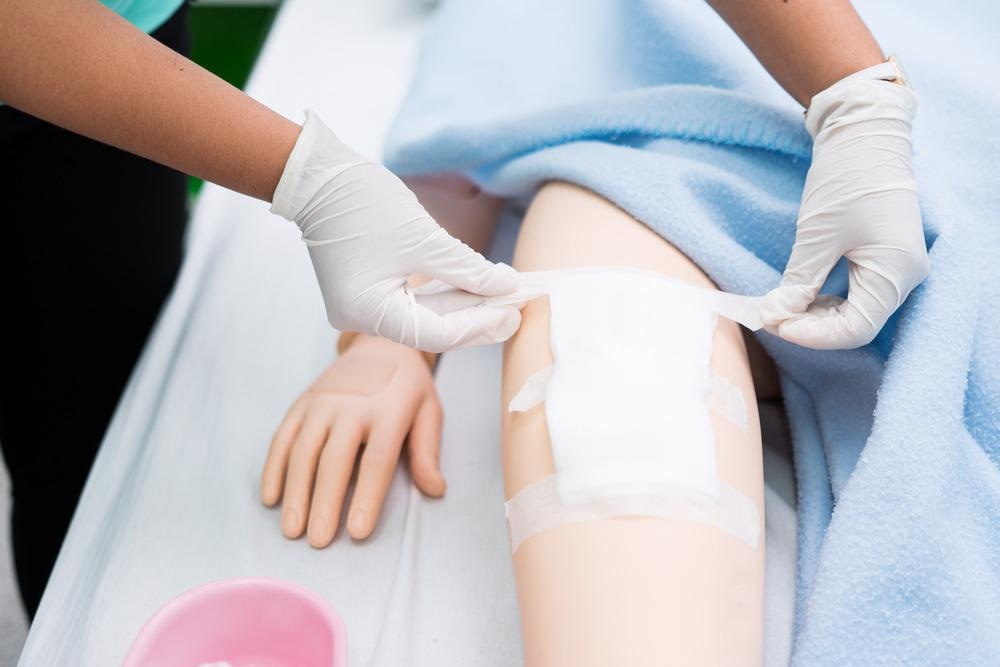The electromagnetism of cellulose nanocrystals (CNCs) in an alginate-silk fibroin (ASF) composite under a low-strength magnetic flux (MF) was used to fabricate a ferromagnetic oriented, anisotropic, three-dimensional tissue repair scaffold, according to a recent article available as a pre-proof in Carbohydrate Polymers.

Study: Magnetic field-assisted aligned patterning in an alginate-silk fibroin/nanocellulose composite for guided wound healing. Image Credit: Bangkoker/shutterstock.com
Cellulose nanocrystals's magnetic properties could be beneficial in the development of biomimetic anisotropic constructions for wound healing
Importance of Skin Tissue Engineering
The rising expense of treatment is having a negative effect on the economic strain of healing wounds. As a result, addressing wound management technology has become an urgent requirement to sustain patients' decent standard of living.
Sutures, linen, and sterile gauzes are conventional wound dressings that do not produce the necessary conditions for wound healing. As a possible substitute, skin tissue engineering is a fast-growing field of study aimed at reasserting cellular activities, re-epithelialization, and capillary density in injured tissue to provide efficient medical coverage. One of the most promising tissue engineering techniques for mending injured epidermis is the insertion of bioinspired structures with a favorable three-dimensional (3D) shape mimicking the extracellular matrix (ECM) of the body tissue to stimulate cutaneous, epithelial, and angiogenic development.
Scaffold-Guided Wound Healing Platforms
Various scaffold-guided wound repair scaffolds have been developed to generate remarkable tissue regeneration results. Superior mechanical qualities, permeability, adaptability, and ECM-mimicking shape are only a few of the major characteristics of these scaffolds. Natural polymers capable of changing into 3D forms in response to environmental factors have received much interest among these novel bandages.
The electromagnet field (MF), in particular, has been thoroughly researched as an external stimulus for influencing scaffold configurations, such as microhardness patterns and inhomogeneous configurations. To boost the wound healing effects of fibroblasts, an embedded framework comprising a ferromagnetic scaffold with MF stimulus can be employed. To imitate the tensile forces inherent in natural systems, MF-responsive ferrogels with adjustable mechanical characteristics upon MF stimuli have also been synthesized.
Cellulose nanocrystals for Tissue Engineering Applications
Because of the intrinsic crystallographic orientation inside individual CNCs, which is susceptible to MF stimulus, cellulose nanocrystal (CNC)-reinforced polymer nanocomposites have garnered attention. This ability of CNC directional orientation has been employed in several pioneering efforts to regulate the integration of starch-based polymeric composites and enhance the mechanical efficiency of nanomaterials for potential tissue engineering applications.
Despite multiple studies on the manufacture of biomedical substrates using CNCs' magnetic sensitivity, the production of an asymmetric scaffold that mimics skin heterogeneity has yet to be thoroughly investigated. Furthermore, the physiological reaction of the cocultured epidermis, fibroblast, and microvascular skin cells on a magnetically oriented CNC-containing substrate has yet to be researched as well.
A Novel CNC-reinforced Nanocomposite for Wound Healing
The main objective of this work was to study how CNC-induced scaffolding morphology management affected the healing process in an Alg-SF-CNC nanocomposite when it was stimulated by MF.
A low-intensity magnetic field was used to successfully regulate the morphology of the CNC-reinforced nanocomposite for controlled wound healing. The biochemical characteristics of the manufactured scaffolds were investigated. In an in vivo dermal wound model, the healing effects of the scaffold structure achieved on fibroblast cells, epithelial tissue, and endothelium were also demonstrated.
Research Conclusion and Prospect
The impact of a low-strength magnetic flux on the structure of CNC-based nanocomposites was explored in this paper. The findings revealed that exposing the manufactured nanocomposite to a magnetic force for eight hours had a substantial influence on the overall polymeric orientation.
Increased concentration of CNC in the Alg-SF matrix material enhanced the mechanical and physical characteristics by increasing molecular packing and parallel orientation. Physiological reactions of cells cultivated on the ASC-0.5 scaffold verified the increased cell growth.
The function of morphology in wound healing was further validated by altered expression of tissue repair genetic markers, enzymes, and growth regulators.
The associated scaffold's wound healing potential was further tested in a rat model, indicating its biocompatibility. As a result, using CNCs in a low-strength magnetic force can greatly aid in creating an oriented polymeric scaffold, opening the road for CNCs to be used as a good MF-sensitive nanomaterial for tissue engineering applications.
Reference
Ganguly, K. et al. (2022). Magnetic field-assisted aligned patterning in an alginate-silk fibroin/nano cellulose composite for guided wound healing. Carbohydrate Polymers. Available at: https://www.sciencedirect.com/science/article/pii/S0144861722002259
Disclaimer: The views expressed here are those of the author expressed in their private capacity and do not necessarily represent the views of AZoM.com Limited T/A AZoNetwork the owner and operator of this website. This disclaimer forms part of the Terms and conditions of use of this website.